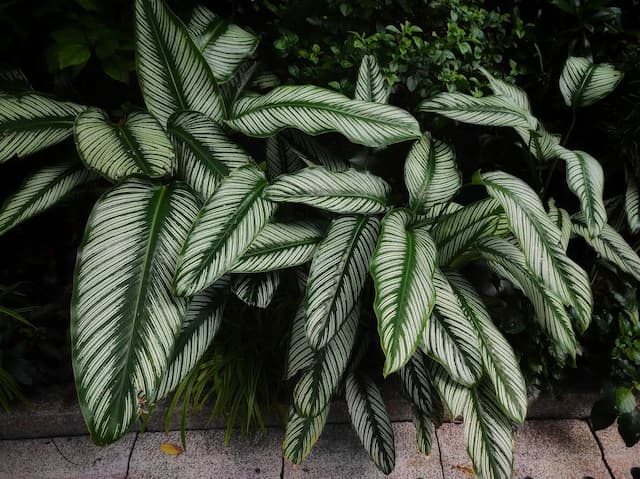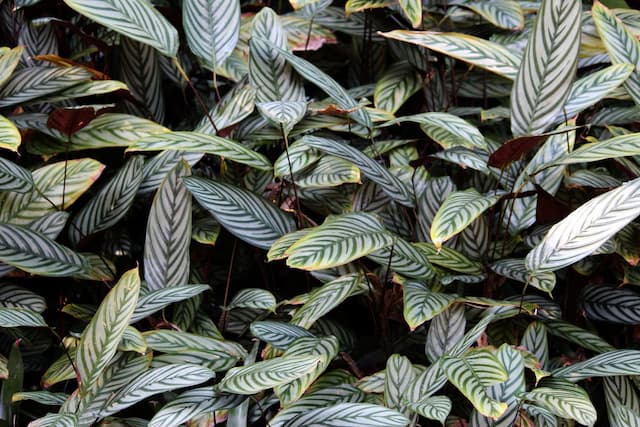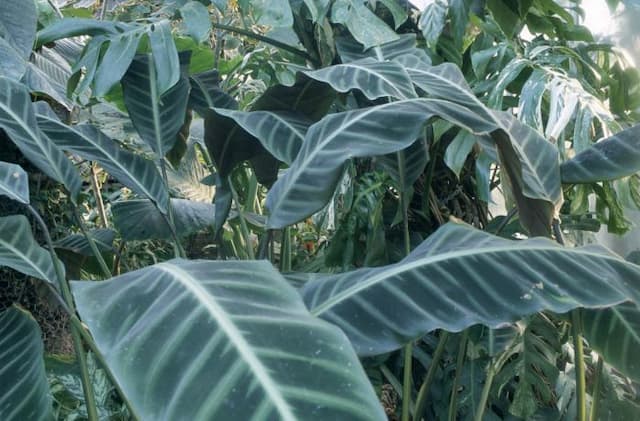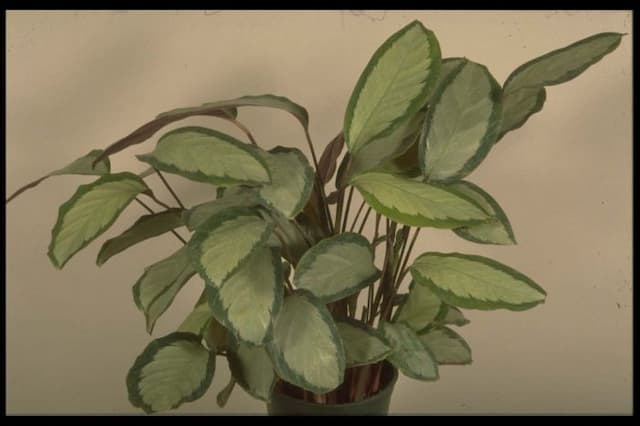Prayer plant Maranta leuconeura



ABOUT
Maranta leuconeura, also known as the prayer plant, is a variable, rhizomatous, clump-forming perennial plant that is native to Brazil.
It is characterized by its striking, patterned leaves that are typically green with white or light green veins. The leaves are oval-shaped and grow on long, slender stems. The plant is called a prayer plant because it folds its leaves at night.
The plant produces small, inconspicuous flowers that are typically white or pink in color. The prayer plant is a small, low-growing plant that typically 12 inches tall and height with crowded clumps of evergreen, strikingly-marked oval leaves, up to 5 inches long. It is an attractive, low-maintenance plant that is well-suited to a variety of indoor environments.
About this plant
 Names
NamesFamily
Marantaceae
Synonyms
Herringbone plant, Red-veined prayer plant, Ten commandments, Peacock plant, Rattle snake plant, Zebra plant
Common names
Calathea leuconeura, Maranta massangeana, Calathea kerchoveana, Maranta kerchoveana, Maranta kerchovei, Maranta leuconeura var. kerchoveana, Maranta leuconeura var. massangeana,
Calathea massangeana, Maranta massangeana atrata, Maranta massangeana florentina, Maranta massangeana metallica, Maranta leuconeura var. erythroneura
 Toxicity
ToxicityTo humans
It is not known to be poisonous if ingested, and it is not known to cause skin irritation or other adverse effects.
However, as with any plant, it is always best to use caution and keep it out of reach of children, just to be safe. If you suspect that your child or pet has ingested any part of the plant, it is important to contact your doctor or veterinarian immediately for further advice and treatment.To pets
It is not known to be poisonous if ingested, and it is not known to cause skin irritation or other adverse effects.
However, as with any plant, it is always best to use caution and keep it out of reach of pets, just to be safe. If you suspect that your child or pet has ingested any part of the plant, it is important to contact your doctor or veterinarian immediately for further advice and treatment.
 Characteristics
CharacteristicsLife cycle
Perennials
Foliage type
Evergreen
Color of leaves
Green with white or light green veins
Flower color
White
Height
Up to 12 inches
Spread
Up to 12 inches
Plant type
Shrub
Hardiness zones
9
Native area
Brazil
Benefits
 General Benefits
General BenefitsThe prayer plant is known to be effective at removing toxins from the air, making it a great choice for improving indoor air quality;
The prayer plant is relatively low-maintenance and is easy to care for, making it a great choice for those who are new to gardening or who don't have a lot of time to devote to plant care;
The prayer plant is an attractive plant that adds a touch of greenery to any room, making it a popular choice for home decor;
The prayer plant is a tough and resilient plant that is able to withstand a range of growing conditions, making it a good choice for those who may not have a green thumb. Medical Properties
Medical PropertiesSome people believe that the prayer plant has medicinal properties and may be effective in treating a range of conditions. It is said to have anti-inflammatory properties and may be helpful in reducing swelling and inflammation. It is also said to have astringent properties and may be helpful in treating wounds and other skin conditions.
However, it is important to note that the medical properties of the prayer plant have not been extensively studied and it is not currently considered a viable treatment for any medical condition. Air-purifying Qualities
Air-purifying QualitiesAs mentioned earlier, the prayer plant is known to be effective at removing toxins from the air, making it a great choice for improving indoor air quality. It is thought to be particularly effective at removing formaldehyde, which is a common indoor air pollutant.
Interesting Facts
 Feng Shui
Feng ShuiIn feng shui, the prayer plant is thought to bring good luck and positive energy to a space. It is believed to be particularly effective at promoting harmony and balance, and is often placed in areas of the home or office where these qualities are desired.
 Plant Symbolism
Plant SymbolismThe prayer plant is often associated with a number of positive symbolic meanings. It is often seen as a symbol of faith, prayer, and spirituality, and is thought to bring positive energy and good luck to those who have it in their home or office.
It is also sometimes seen as a symbol of peace and tranquility, and is thought to promote a sense of calm and relaxation.
 Water
WaterThe prayer plant should be watered when the soil is dry to the touch. It is important to avoid letting the soil dry out completely, as this can cause the plant to wilt. Water the plant thoroughly and allow the excess water to drain away, as the plant does not like to sit in standing water.
In general, the prayer plant should be watered once a week, but this can vary depending on the humidity and temperature in your home. Light
LightThe prayer plant prefers bright, indirect light. It can tolerate low light conditions, but it may not grow as well and may not produce as many leaves. Avoid placing the plant in direct sunlight, as this can cause the leaves to become scorched or faded.
 Temperature
TemperatureThe prayer plant is native to tropical regions and prefers warm, humid conditions. It can tolerate a wide range of temperatures, but it grows best at temperatures between 60-80 degrees Fahrenheit.
It can survive temperatures as low as 50 degrees Fahrenheit, but it may become dormant in these conditions. Pruning
PruningTo prune Maranta leuconeura, use clean, sharp scissors or pruning shears to remove any yellow, dead, or diseased leaves. You can also trim the plant to maintain a desired shape or size.
 Soil
SoilThe best soil for Maranta leuconeura is a well-draining, peat-based potting mix. It is important that the soil is well-draining to prevent root rot, as Maranta leuconeura is susceptible to this disease. The soil should also have a slightly acidic pH between 6.0 and 6.5. Adding perlite or pumice to the soil can help improve drainage. It is also a good idea to use a pot with drainage holes to allow excess water to drain out.
 Repotting
RepottingWhen repotting Maranta leuconeura, choose a pot that is slightly larger than the current one and has drainage holes to prevent excess water from accumulating.
Repot the plant in the spring, when the roots have outgrown the current pot or when the plant becomes top-heavy. Be careful not to disturb the roots too much when transferring the plant to the new pot. Humidity & Misting
Humidity & MistingThe best humidity level for Maranta leuconeura is around 50-70%. It is important to keep the humidity level consistent for this plant as it is native to tropical rainforests and is used to high humidity levels.
You can increase the humidity around the plant by misting the leaves regularly or placing a humidifier near the plant. You can also place the plant on a tray filled with pebbles and water, making sure the bottom of the pot is not sitting in the water. This will allow the plant to absorb moisture from the air. Suitable locations
Suitable locationsIndoor
All year round
Outdoor
Prayer plant can be grown outdoors in warm, humid climates.
It is native to the tropical regions of South America and prefers partial shade and moist, well-draining soil. It is important to protect the plant from direct sunlight, as it can cause the leaves to fade or burn.Hardiness zone
10 - 11 USDA
 Life cycle
Life cyclePrayer plant is a perennial plant that is native to the tropical regions of Brazil. It is known for its colorful, patterned leaves and its habit of folding its leaves upward at night, which is where it gets its common name.
The plant has a life cycle of several years, during which it will grow, flower, and produce seeds. It goes through a dormant period during the colder months, during which it may lose some or all of its leaves. After the dormant period, the plant will begin to grow again and produce new leaves. Propogation
PropogationPropogation time
Spring
By STEM CUTTINGS:
To propagate through stem cuttings, cut a stem with at least two sets of leaves and remove the lower leaves. Place the stem in a pot filled with moist soil or rooting hormone and cover with a plastic bag to create a humid environment. Place the pot in a bright, indirect light location and keep the soil moist. The stem should root within a few weeks.
By DIVISION:
To propagate through division of the rhizomes, carefully separate the rhizomes and plant each one in a separate pot filled with soil. Water the rhizomes and keep them in a bright, indirect light location. The Maranta leuconeura plants should establish themselves within a few weeks.
 Pests
PestsSpider mite, Mealybug, Aphid
 Diseases
DiseasesRoot Rot









